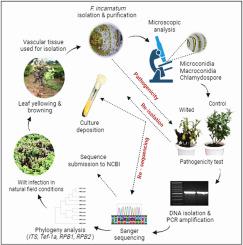Physiological and Molecular Plant Pathology ( IF 2.7 ) Pub Date : 2023-12-28 , DOI: 10.1016/j.pmpp.2023.102214 Alexander Balamurugan , Mushineni Ashajyothi , Kumar Shanu , Krishnappa Charishma , Hiremath Varun , Kumar Gunjeet , Aundy Kumar

|
During the 2019 and 2020 planting seasons, an unexpected and rapid wilting disease affected chrysanthemum fields, impacting both the Pusa Centenary and Karnal Pink cultivars. Affected plants displayed initial signs of lower leaf yellowing, progressing to leaf browning and defoliation, followed by partial wilting. This disease eventually led to complete plant collapse, marked by vascular browning and eventual death. Upon isolation, the fungus linked to this wilt displayed whitish mycelium initially, evolving into light yellow aerial mycelium and brown pigments as it matured. Detailed examination of the purified fungus from these chrysanthemum cultivars identified it as Fusarium incarnatum-Equiseti species complex (FIESC). Pathogenicity tests confirmed its ability to induce wilt symptoms in six-week-old chrysanthemum seedlings within 6–12 days post-inoculation using a soil-inoculation method. To validate the identity of the isolates, sequencing was performed using multi-gene regions (ITS, Tef-1α, RPB1, and RPB2), and analysis through Fusarium-ID and Fusarium-MLST databases definitively categorized the pathogen as Fusarium incarnatum. Moreover, molecular phylogenetic analysis placed the Fusarium isolates within the Incarnatum group. This study establishes the association of Fusarium incarnatum (FIESC) with chrysanthemum wilt, backed by a comprehensive range of pathological, symptomatic, cultural, microscopic, and molecular-taxonomic tools. The findings are expected to significantly aid in pathogen detection, accurate species identification, and highlight the need for specific marker genes to understand pathogen diversity, ultimately assisting in the development of effective disease management strategies in the future.
中文翻译:

由镰刀菌引起的菊花枯萎病:通过多相分类学方法揭示病因学
在 2019 年和 2020 年种植季节,一种意想不到的快速枯萎病影响了菊花田,影响了 Pusa Centenary 和 Karnal Pink 品种。受影响的植物最初表现出下部叶片变黄的迹象,随后进展为叶片褐变和落叶,随后部分枯萎。这种疾病最终导致植物完全崩溃,其特点是维管束褐变并最终死亡。分离后,与这种枯萎病相关的真菌最初显示出白色的菌丝体,随着成熟而演变成浅黄色的气生菌丝体和棕色色素。对这些菊花品种纯化的真菌进行详细检查,确定其为Fusarium incarnatum - Equiseti物种复合体 (FIESC)。致病性测试证实其能够在使用土壤接种法接种后 6-12 天内诱导六周龄的菊花幼苗出现枯萎症状。为了验证分离株的身份,使用多基因区域(ITS、Tef-1α、RPB1和RPB2)进行测序,并通过Fusarium -ID 和Fusarium -MLST 数据库进行分析,最终将该病原体归类为Fusarium incarnatum。此外,分子系统发育分析将镰刀菌分离株归入Incarnatum组。这项研究建立了镰刀菌(FIESC) 与菊花枯萎病的关联,并得到了一系列病理学、症状、培养、显微镜和分子分类学工具的支持。这些发现预计将极大地帮助病原体检测、准确的物种鉴定,并强调需要特定的标记基因来了解病原体多样性,最终有助于未来制定有效的疾病管理策略。



























 京公网安备 11010802027423号
京公网安备 11010802027423号